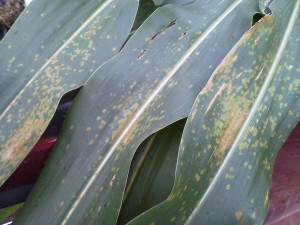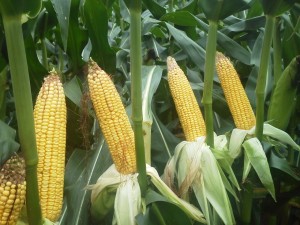We have all been hearing reports of Southern Rust on corn from SW Georgia to North Florida. Area farmers are making some difficult decisions as they strive to produce the best crop they can with maximum economic returns. I heard reports through the farmer grapevine of Southern rust on one farm field in the county and after a field visit I am confident that was an accurate diagnosis. I sent sample to the University of Florida Plant Pathology Lab for confirmation, but it looks like a match to me. I also had a farmer drop off samples from Gilchrist County with the same symptomology. I spent more time in area fields, and depending on how long you look, I think someone could make a find in every field.
Dr. Kemearait, UGA plant pathologist, recommended we be ready following the last tropical weather system, and the environment has just been right. The rust I was finding in area fields on 6/21 and 6/22 was at very low levels. Mainly what I am seeing matches my expectations of Southern Rust. I am finding it 16 to 17 days after application of fungicides in these fields. Many of our fields were sprayed at mid pollination to brown silk, and the fungicide did it’s job to keep disease levels low until the ear developed. Now the protection form those fungicides is wearing off.
Most of the irrigated corn in the county is at dent stage or later, and in no cases did I recommend an additional spray. I had a discussion with Dr. Nick Dufault, UF plant pathologist, regarding his recommendations. He was confident in only rare cases would a fungicide application at dent stage be valuable. He said that most research shows fungicide sprays for southern rust generally offer a return equal to their cost when 20% of the leaves have rust symptoms. In all the area fields I observed, disease incidence was below 2% of leaves, and most fields were at dent stage.
We have a few late planted dryland fields around that are showing excellent yield potential because of the consistent rainfall since June 1. Most of these farmers are scouting weekly for southern rust and will apply a fungicide due to the increased disease risk of the late planting, consistent rainfall, and disease incidence throughout the area.
Here is a video of an airplane applying fungicide. Sorry this is not mobile device friendly due to youtube file sharing.


